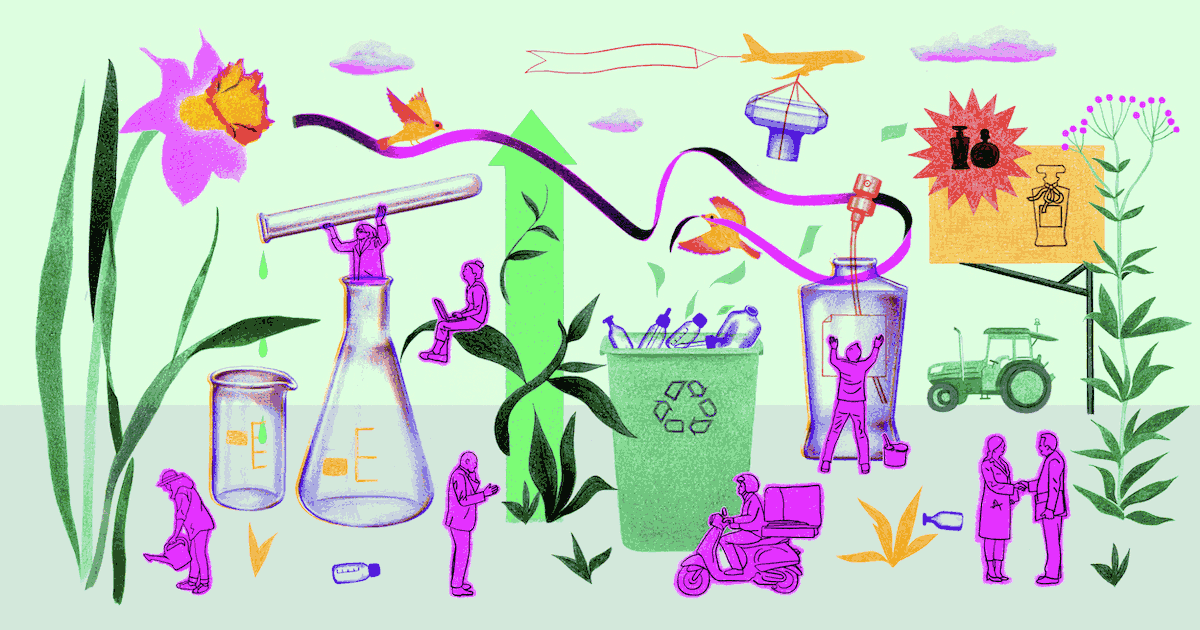Cette publication est également disponible en :
Français
“Sustainable, responsible, eco-luxury, eco-designed, recycled, recyclable, reusable, solidarity-based, traceable, XX% natural origin, carbon neutral, vegan, cruelty-free, clean, good for you, good for the planet…” A plethora of magical terms have sprung up in recent years in the messaging that accompanies perfume launches, employed equally by the largest international cosmetic groups and new independent brands with limited distribution. Is sustainable perfumery possible ? Nez investigated.
While the original intention is commendable, the implementation of these concepts and the lack of transparency in terms of the means used are unfortunately more akin to a form of greenwashing to make people feel less guilty, as can be observed in the food sector.
A sign of growing interest in the subject, since 2020 there has been an “eco-responsible perfume” filter on the French Sephora website (which seems to bring up almost all the current best-sellers, with Sauvage by Dior topping the list), referring to several labels: good for a better planet – “positive gestures to take better care of the planet” – is meant to guarantee “eco-designed packaging and/or responsible sourcing of ingredients”. The “vegan perfume” filter (good for vegans) produces a list of 131 products that do not contain animal ingredients (forgetting of course to point out that very few perfumes today use them, and that a fragrance without the label in question is not necessarily “cruel to animals”). As for “natural perfume”, this filter is associated with the “good for you” notion, and includes, for example, all the Atelier Cologne products, which claim to contain “91% naturally sourced” ingredients (without specifying whether this refers to the perfume’s formula or to the finished product, and without explaining why it would be better for you).
This prime example of a communication method that has become ubiquitous, whether at Sephora or in the press, highlights the sad reality of excessive use of oversimplification, the absence of useful information, and the absurdity of this kind of tool: without taking the time to explain and qualify, it only sows confusion and doubt, fuelling speculation and therefore fear. As a result, the race is on to produce the best label, which will come out the winner regardless of the reality behind it.
These terms, which do not convey much in the way of tangible information, only reinforce the idea that perfume is suspect, and that we should therefore turn to the brands that claim to do something about it. Yes, but what exactly? That’s much harder to find out. What practices are behind all these slogans? What does the notion of sustainability mean for perfumery, an industry whose market is worth nearly 35 billion dollars overall, with experts predicting that the figure will double in the years to come1Source: https://www.fragrancefoundation.fr/2021/03/la-parfumerie-francaise-est-en-pleine-expansion, and which, in the wake of an unprecedented pandemic depriving many people of their sense of smell, is enjoying a defiantly robust 10% growth rate?
Although the question of limited resources began to emerge towards the end of the 18th century with the dawn of the industrial revolution, the notion of sustainable development only appeared for the first time in 1980, when the International Union for Conservation of Nature (IUCN) published a report entitled World Conservation Strategy.
The term was adopted at the 1992 Rio de Janeiro summit as a way of combining the three pillars of development: environmental, social and economic.
Today, the concept is criticised for suggesting that the economy can be developed while protecting the environment and its resources. In other words, holding out the mirage of infinite growth in a finite world.
While the concept of eco-responsibility is spreading within the perfume industry at the same frantic pace as new launches, what it actually implies seems much less visible and tangible than its claims. There are plenty of words, assertions and declarations, but, as is often the case in an industry that likes to cultivate secrecy, there are also a lot of simplifications and slogans, with few substantiated and nuanced messages to better explain what it’s all about and help people make informed choices.
Does the fact that less than 1% of an ingredient in a perfume’s formula is organically grown weigh more in the ecological balance than the thousands of bottles produced that had to be transported by truck, packed in vast swathes of cellophane? Or than the hundreds of press releases sent individually to each journalist?
Another aspect is that the emphasis is often on eco-responsibility, sometimes to the detriment of the social dimension of sustainable development: when a product boasts of being good for the planet or good for you, is it also beneficial to the people who grow or transform the perfume plants, in countries that are geopolitically and economically fragile?
Continuing on the path that began with a detailed examination of natural perfumery in late 2021, Nez invites you to go beyond press kit catchphrases as it provides an in-depth and transparent exploration of the different practices and possible approaches to make perfume, at all stages of its life, more compatible with a better future. From the cultivation of perfume plants, their transformation and the synthesis of molecules to the fate of unsold bottles, quantities of waste generated and recycled, tools available to perfumers and the different elements of packaging, we are taking you on a deep dive into the world of sustainable development in perfumery.
—
Summary
- Is sustainable perfumery possible?, by Jeanne Doré
- Natural raw materials: plants, essences and people, by Jessica Mignot
- Towards a more virtuous synthesis?, by Anne-Sophie Hojlo
- Responsible formulation: different tools, one ideal, by Sarah Bouasse
- Inside the lab: rationalising, not rationing!, by Aurélie Dematons
- When packaging goes green, by Delphine de Swardt
- Scents in circulation: perfume life cycles, by Clément Paradis
Illustration : Marie Duval








Comments